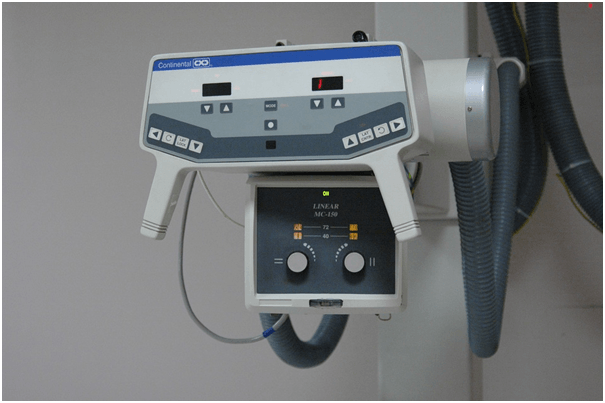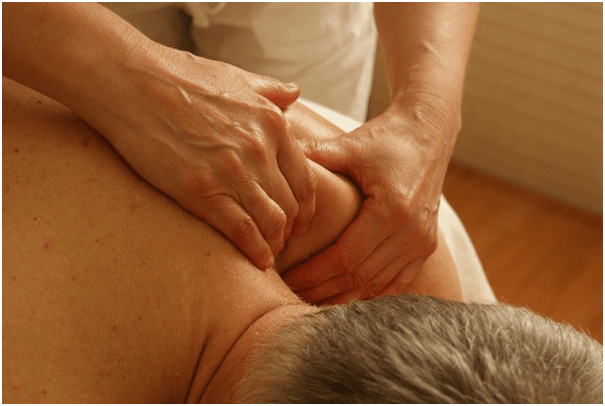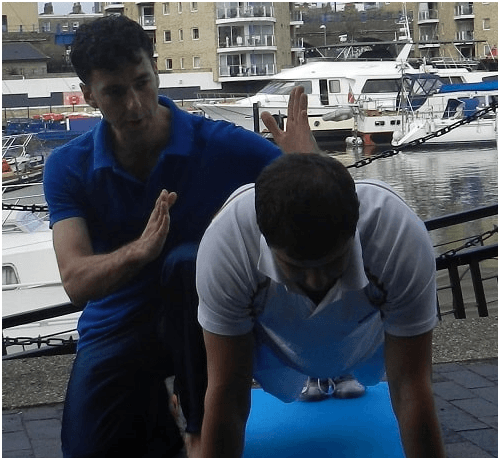Shoulder pain is exceptionally common in the worldwide population.
With a shoulder training personal trainer, many people would be able to improve their symptoms.
Customised shoulder exercises personal training provide the injured person with specific exercises and activities that specifically focuses on the shoulders – strengthening the muscles, recreating optimum movement, achieving balance and improving flexibility in the region.
Symptoms can range from mildly restrictive pain and inflammation, toward more severe symptoms that can cause a person to experience disability.
This study found that the lifetime prevalence and risk for shoulder pain might be as high as 76%1.
 Pain affecting the shoulders is often accompanied by additional symptoms.
Pain affecting the shoulders is often accompanied by additional symptoms.
Understanding the potential causes for the shoulder pain and the underlying conditions that may contribute to symptoms affecting the shoulders is important.
Several treatment methods have also been advised for individuals experiencing pain in their shoulders, ranging from the use of medication toward alternative practices, such as tailored exercises and 121 injury rehabilitation.
When shoulder pain is a chronic issue, a personalised solution may help you understand how you can improve muscle strength, enhance flexibility, and restore the range-of-motion in your shoulders.
Start with a FREE CONSULTATION to see how simple exercises could bring you great benefits.
Understanding The Anatomy Of The Shoulder
The shoulder is a fairly complex structure in the body and plays an essential part in allowing a person to move their arms and function normally.
The shoulder consists of two major joints – this includes both the glenohumeral joint, as well as the acromioclavicular joint.
The collar bone and the shoulder blade meet at the acromioclavicular joint.
At the glenohumeral joint, the glenoid socket meets the humeral head, often referred to as the shoulder ball.
The shoulder also consists of four important muscles, including2:
- Subscapularis
- Teres minor
- Infraspinatus
- Supraspinatus
Tendons in the shoulder keep the muscles attached to the bones that are also present in the shoulder.
The muscles then help to move bones in the shoulder, which allows for movement.
Any part of the shoulder can become injured and damaged, which can lead to pain and accompanying symptoms.
There are also many ways in which such injuries can occur – in some cases, the issue at hand may be more serious and causes tendons to detach from muscle or bone tissue.
Symptoms That Often Accompany Shoulder Pain
The pain would be the primary symptom experienced by the individual affected, but certain symptoms may accompany the painful sensations.
It is important to consider the fact that certain details of symptoms experienced can often assist in helping to determine whether the pain and accompanying issues may be serious or rather not to be concerned about.
In particular, it is crucial to consider whether the pain is dull or sharp and whether the pain is mild or more severe.
Furthermore, the onset of the pain may be sudden or rather gradual.
Pain symptoms can sometimes be aggravated by overuse of the shoulders, as well as through daily activities.
In some cases, inactivity may also cause a worsening of symptoms.
A person should also be aware of accompanying symptoms that are present, along with the shoulder pain.
These particular symptoms may include:
- Moving the shoulder may be difficult or, in some cases, even be impossible
- Muscle spams may occur in the affected shoulder
- A numbness may accompany the pain
- Weakness may be experienced in the shoulder and the arm
- Stiffness may also occur
- The shoulder may become swollen
- There may be a visible deformity
Shoulder pain can be deliberating and even disabling at times, but with the customised rehab plan set in motion, you could experience relief of your symptoms.
You can find out how a personalised shoulder pain exercise plan could help you cope and depending on your diagnosis possibly improve your symptoms – get started with a free consultation
Potential Causes Of Shoulder Pain
There are quite a large number of potential causes for the development of shoulder pain, as well as the symptoms that commonly accompany such pain.
One of the most common causes throughout the general population would be shoulder impingement, a relatively well-known term that refers to a range of issues that causes the symptoms we described earlier.
Shoulder impingement
With a shoulder impingement, there is a tendon in the shoulder that usually rubs against bone and other tissues that are located close to the tendon, especially when the arm is lifted.
The tendon of the rotator cuff is usually affected by a shoulder impingement.
Potential issues that may lead to a shoulder impingement include3:
- A bursa
- Bursitis
- Overuse of shoulder joints
- Direct injury to the shoulder joints
- The congenital issue, such as when the acromion has a curve instead of a flat structure
- Spurs, or bony growths, that develop onto the acromion
Diagnosing Shoulder Pain

When a person complains about shoulder pain at a doctor or physiotherapist, they will usually be asked to undergo a number of tests.
First, the professional will have to conduct a thorough physical examination of the individual.
This will help the doctor identify potential issues like swelling and perhaps even deformities affected the shoulder.
The range of motion should also be examined by the doctor or by a physiotherapist.
In addition to considering the physical attributes of the shoulder, the doctor will also take a closer look at the neck and the arms, as well as the elbows of the individual.
Specific tests that the physician may also use include4:
- Rotator cuff evaluation
- Provocative testing
- Hawkins’ test
- Neer’s test
- Cross-arm test
- Drop-arm test
- Instability testing
- Apprehension test
- Yergason test
- Relocation test
There are various tests that can be used.
X-rays can be taken on the individual’s shoulder to help the physician determine if there is any structural damage that could be causing the symptoms experienced.
Maximise your injury recovery by training with established shoulder rehabilitation specialist in London
Pharmaceutical Drugs For The Relief Of Shoulder Pain Symptoms

A person with shoulder pain, stiffness, swelling, and accompanying symptoms may opt for over-the-counter medications, as well as prescription drugs, to assist in relieving the pain and other issues.
There are many drugs that can assist in reducing inflammation, as well as to block pain receptors.
Common medications that may be provided to a person with shoulder pain can include5:
- NSAIDs – Also known as nonsteroidal anti-inflammatory drugs, this type of medication can help to target both inflammation in the shoulder, as well as pain.
They are commonly used by people with joint-related pain and may be useful in shoulder pain.
- Analgesic Medications – This type of medication is considered somewhat safer than NSAIDs as the drugs do not cause the same side-effects associated with NSAIDs.
It should, however, be noted that an analgesic drug will only target pain and not assist in reducing inflammation and swelling.
- Corticosteroid Injection – Since shoulder pain is localised, a physician may decide to provide the person affected with a corticosteroid injection.
Oral drugs containing corticosteroids are usually not used since these are preferred in people with systematic inflammation.
The corticosteroid solution can help to control inflammation around the shoulder joint.
Conventional Treatment Options In Shoulder Pain
The treatment preferred for a person with shoulder pain really depends on the cause behind their symptoms.
In some people, the use of the medications that we looked at in the previous section may be sufficient to temporarily reduce inflammation and pain while the problem at hand is recovering.
In other cases, however, more serious interventions may be needed.
There are certain types of surgical procedures that may be recommended to a person with shoulder pain caused by more serious damage, such as where there is a displacement in their shoulder joints, or when severe damage has been suffered by the shoulder.
Alternative Therapies For Shoulder Pain

Certain alternative therapies may also be suggested for the management and alleviation of shoulder pain.
An injured person may be advised to undergo 121 customised personal training shoulder rehabilitation, and the personal trainer will be working alongside your physiotherapist.
This will usually provide the injured individual with a range of physiotherapy exercises for shoulder and arm pain.
The amazing benefits of physiotherapy exercises for neck and shoulder pain may be provided when the individual’s neck is also affected.
Other options for shoulder injury treatment may also include the use of herbal medicines to help reduce symptoms, such as the swelling that has developed.
Acupuncture is also an alternative therapy that has been suggested in many cases.
In a study6 conducted by researchers at the Johns Hopkins Bayview Medical Center, a team considered the efficiency of acupuncture for the treatment of chronic shoulder pain.
There was a total of 31 participants in the study.
The study found that acupuncture provided a clinically significant level of relief in the pain symptoms experienced by the participants.
Injury Rehabilitation May Help With Shoulder Pain
In cases where a person has suffered an injury to the shoulder that results in inflammation, pain, stiffness, and a loss of their flexibility, injury rehabilitation becomes a necessity.
While there are many techniques that can assist in relieving generalised shoulder pain, with injury, there is often tissue damage that may become worse when some of the generalised solutions are opted for.
A customised solution is what the patient will require – one that focuses on the specific injury they had suffered. This may include the use of ice packs, as well as heat therapy.
Certain types of exercises may be advised to the individual – these exercises will specifically focus on improving their shoulder without causing further damage to the underlying structures.
Get now your complete customised shoulder rehabilitation to improve and get rid of any type of shoulder injury, background shoulder pains effectively.
Exercises That May Assist In Improving Symptoms

There are some forms of physical exercises that may also be useful for improving muscle strength in the shoulders.
Many of these exercises may also assist in alleviating the pain symptoms that a person may be experiencing.
Several studies have shown that specific types of exercises can be useful for both shoulder pain and accompanying symptoms; however, all these will require to be customised to your type of injury.
In one study7, a group of industrial workers was assigned to a random group.
All participants in the study complained about persistent neck and shoulder pain.
One group was provided with a series of high-intensity strength training shoulder pain exercises that focused on shoulder and neck muscles.
There was a significant decrease in the intensity of shoulder pain among the participants who performed these exercises.
In another study8, construction workers were provided with home exercises to perform to a daily basis.
The participants had complained about shoulder pain.
Following a 12-week period, study participants reported a significant improvement in overall shoulder pain and accompanying symptoms.
Jazz Alessi is an elite personal trainer who has helped a large number of people with shoulder pain rehabilitation, whether the pain is chronic or caused by an acute injury.
He offers a free initial consultation to help clients understand what he can do for them.
Rehabilitation Exercises ByElite Personal Trainer To Reduce Shoulder Pain Symptoms
While several types of exercises have been scientifically proven to be beneficial for individuals with shoulder pain, it is important to consider the fact that not all types of physical activity may be safe.
It is crucial to understand that the underlying causes of the shoulder pain need to be taken into account.
With this in mind, an elite personal trainer specialised in shoulder rehab perfectly understands a person physiotherapy history and alongside client clearance to exercise will provide them with an appropriate rehab programme that is designed for their specific needs.

This way, the programme would not only be safe for them, but also focus on the particular areas that are causing them to suffer from shoulder-related pain, stiffness, and perhaps even a loss of their motion in the shoulder joint.
Such a programme could perhaps include a range of customised neck and shoulder pain exercises and stretches.
At the same time, shoulder pain rehab exercises should take into account any existing injury that the patient had suffered and avoided further damage.
With the right types of physical exercises, combined with a personalised programme that takes specific injuries into account, shoulder pain and tension can be progressively relieved without risks of further damage.
Jazz Alessi has been providing his VIP clients with a free consultation to help them understand how exercises could be useful for them.
Jazz Alessi – Elite Personal Trainer For Shoulder Rehabilitation Exercises
Jazz Alessi is an elite level personal trainer in London who is qualified and highly experienced in providing rehabilitation services to clients who have previously experienced shoulder injuries.

This should include comprehensive assessments, followed by focused customised rehab exercises that can help individuals who had suffered a shoulder injury improve the strength and flexibility of shoulder muscles.
The result would, of course, be an improvement in the client’s symptoms.
As an expert shoulder training personal trainer, Jazz will customise a client’s rehab programme to ensure all aspects of the client – including existing health conditions, current activity level, weight, and more – can be taken into account.
This would ultimately provide the client with a safer approach to shoulder injury treatment through 121 expert personal training.
Request now your, Free Consultation!
References
1 A. Cadogan, M. Laslett, W.A. Hing, P.J. McNair, M.H. Coates. A prospective study of shoulder pain in primary care: Prevalence of imaged pathology and response to guided diagnostic blocks. BMC Musculoskeletal Disorders. 28 May 2011. https://www.ncbi.nlm.nih.gov/pmc/articles/PMC3127806/
2 The Anatomy of the Shoulder. Washington University Physicians: Washington University Orthopedics. https://www.ortho.wustl.edu/content/Patient-Care/3127/Services/Shoulder-Elbow/Overview/Shoulder-Arthroscopy-Information/The-anatomy-of-the-shoulder.aspx
3 Shoulder impingement. NHS. 26 Apr 2017. https://www.nhs.uk/conditions/shoulder-impingement-syndrome/
4 T.W. Woodward, T.M. Best. The Painful Shoulder: Part I. Clinical Evaluation. Journal of American Family Physician. 15 May 2000. https://www.aafp.org/afp/2000/0515/p3079.html
5 Medications to Treat Shoulders. Arthritis Foundation. https://www.arthritis.org/about-arthritis/where-it-hurts/shoulder-pain/treatment/shoulder-arthritis-medication.php
6 A.T. Lathia, S.M. Jung, L.X. Chen. Efficacy of acupuncture as a treatment for chronic shoulder pain. Journal of Alternative and Complementary Medicine. Jun 2009. https://www.ncbi.nlm.nih.gov/pubmed/19489707
7 Multiple Authors. Implementation of neck/shoulder exercises for pain relief among industrial workers: A randomised controlled trial. BMC Musculoskeletal Disorders. 21 Sep 2011. https://www.ncbi.nlm.nih.gov/pmc/articles/PMC3188479/
8 P. Ludewig, J. Borstad. Effects of a home exercise programme on shoulder pain and functional status in construction workers. Journal of Occupational & Environmental Medicine. Nov 2003. https://www.ncbi.nlm.nih.gov/pmc/articles/PMC1740414/



